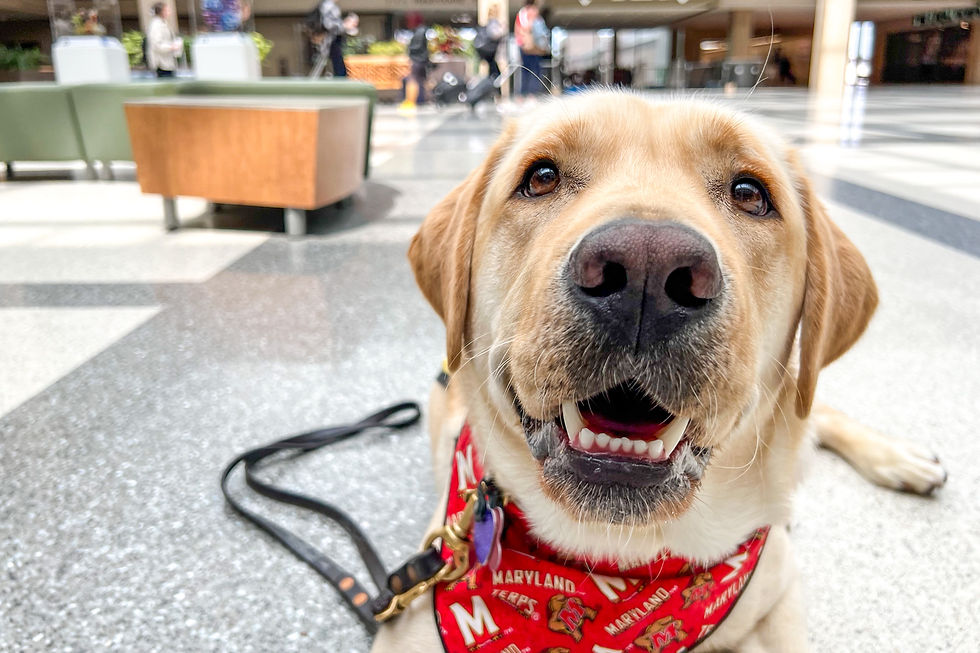Key Service Dog Terms Explained for New Owner-Trainers
- Cate Law
- Sep 19
- 4 min read
Updated: Sep 24

Stepping into the world of service dog training can feel overwhelming, especially with all the new terms and jargon that get thrown around. My goal is to make this journey feel clear, supportive, and even a little fun. In this post, I’m breaking down a few key terms you’ll hear when it comes to training a service dog, from Public Access and Task Training to some others that might not be as familiar. Let’s dive in!
ADA Compliance
This is a legal term that refers to whether or not a service dog is following the rules set by the Americans with Disabilities Act (ADA). For a dog to be considered a service dog, it must be well-behaved in public (Public Access) and be trained to perform specific tasks that assist with a disability (Task Training). ADA compliance also ensures that service dogs are allowed to accompany their handlers in places where pets are otherwise not permitted, such as restaurants and stores.
Alert/Medical Alert Training
Medical alert training is a subset of Task Training. This includes training a service dog to recognize and respond to specific medical conditions, such as seizures, low blood sugar, or anxiety. For example, a diabetic alert dog is trained to sense changes in blood sugar levels and may alert the handler before they experience symptoms. These dogs provide vital support to individuals with certain medical needs by giving them an early warning that allows them to take action in time.
Anchor/Blocking
This refers to a service dog’s ability to create space or prevent others from entering the handler’s personal space. This can be helpful for people with disabilities like PTSD, anxiety, or mobility issues. For example, a service dog trained to "anchor" might stand in front of its handler to block others from crowding or touching them. "Blocking" also refers to a dog’s ability to help its handler navigate through crowded areas or to keep people at a distance when needed.
Handler
A "handler" is the person who works the service dog. This is typically the person with the disability that is benefitting from the service dog. The handler is responsible for providing care, feeding, and general training for the dog, in addition to practicing the tasks the dog is trained to perform. The handler-dog bond is key to successful service dog training, as it’s the handler’s job to reinforce behaviors and ensure the dog is always working in an appropriate way.
Positive Reinforcement Training
Positive Reinforcement is all about rewarding your dog for doing the right thing. Instead of focusing on corrections, we use treats, praise, or toys to encourage good behavior. This method builds trust, strengthens your bond, and helps your dog learn faster by associating positive outcomes with the behaviors you want. It’s a fun, effective way to train that keeps your dog confident and eager to learn!
Public Access
Public Access refers to environments like stores, restaurants, public transportation, or any other public spaces. Often it is used to describe places where pet dogs are not allowed. Service dogs are legally allowed to accompany their handlers in these places, but they must be under control at all times. If your dog disrupts the environment, such as barking, jumping on people, or otherwise being a distraction, they may be asked to leave.
Public Access training focuses on teaching your dog to stay calm and focused in a variety of real-world settings, so they can safely accompany you wherever you go.
SDiT
“SDiT” stands for Service Dog in Training. In short, it means a dog that hasn’t yet completed their service dog training, but is being trained to perform tasks and public access skills for a person with a disability. In Maryland, SDiTs have the same access rights as fully trained service dogs. This does vary state by state as SDiTs are not protected under ADA.
Socialization
Socialization is the process of introducing your dog to new environments, people, and other animals so that they can be comfortable and well-adjusted in a variety of settings. A service dog needs to be socialized to handle public spaces, distractions, and unfamiliar people or situations. It’s a critical component of Public Access training, ensuring that your dog is calm and non-reactive in different environments.
Task Training
Task Training is what differentiates a service dog from a pet dog. This term refers to teaching your dog specific tasks that directly mitigate your disability. Task Training could include anything from retrieving dropped items, alerting to medical conditions, opening doors, or even guiding a person with visual impairments. Every service dog is trained for tasks that are uniquely suited to the handler’s needs.
Understanding these terms is such an important step for every service dog owner-trainer. Whether you’re just getting started or already deep in the process, each of these pieces helps you and your dog work as a confident, capable team.
If you’re ready for more guidance and support, my Service Dog Coaching Program is here to walk you through every step - task training, public access, and everyday real-world skills while helping you build the bond that makes it all possible. You don’t have to do this journey alone.

Comments